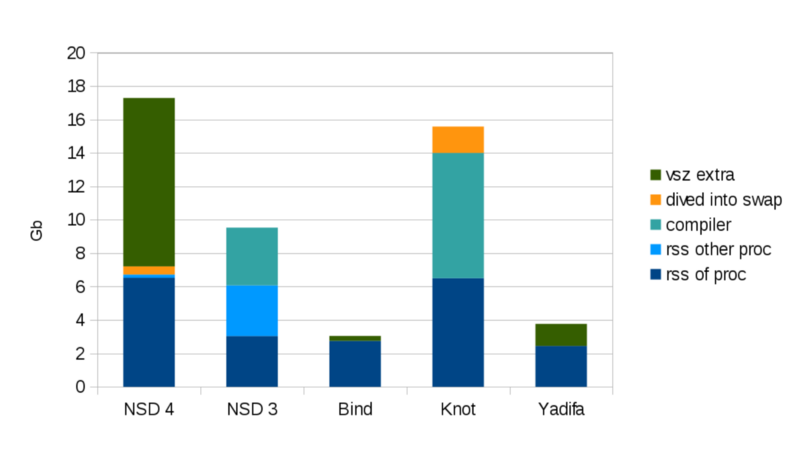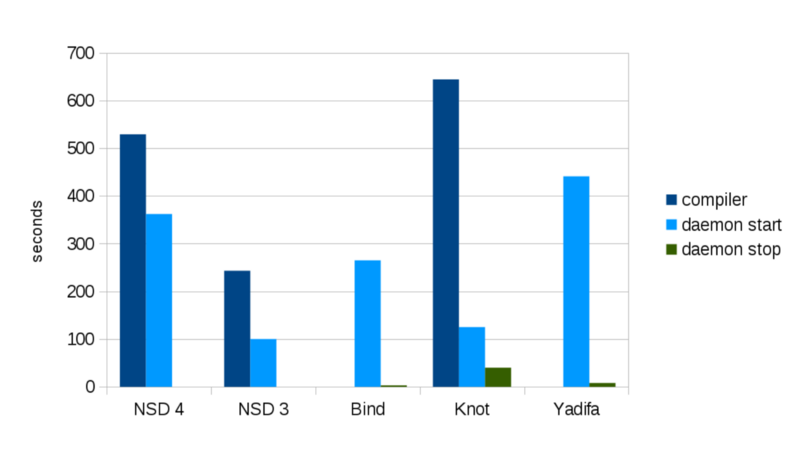NSD4 High Memory Usage

By Wouter Wijngaards
NSD 4 is currently in beta and we are expecting a release candidate soon. This is the second of a series of blog-posts in which we describe some findings that may help you to optimize your NSD4 installation. In the first article we talked about general performance, this article muses about memory usage. (This article is based on the forthcoming nsd-4.0.0b5)
NSD4 Memory usage
The memory intensive architectural trade-off between pre-compiling answers and high speed serving of packets has been part of the NSD design since its first incarnation almost a decade ago.
With NSD 4 we continued the pre-compilation philosophy. It even seems that, compared to NSD 3, NSD 4 uses more memory. Why? How?
Why
Memory is being consumed to achieve speed improvements, but also for improvements such that administrators can update the zones served without needing the restart that so prominently featured NSD 3; NSD 4 can update, add, and remove zones without a restart. NSD 4 can receive IXFR (incremental zone transfers) and apply them in a time that depends on the size of that transfer, independent of zone size. Besides, during an update the database as stored on disk (nsd.db) is updated. On incremental updates of NSEC3 signed zones the nsec3-precompiled answers are all updated as well. All these features, that improve usability and speed imply that disk usage and memory usage increased compared to NSD 3.
How
To compare the memory a Dell PowerEdge 1950 with 8 GB of RAM, a large HDD and 2 GHz Xeon CPU (the same machine used for the performance tests earlier) was used to load the .NL zone (the authoritative Dutch top-level-domain) from June 2013. This is a fairly large zone, its zonefile is about 1.5 GB. It has 5.3 million delegations. It is signed with DNSSEC, and uses NSEC3 (opt-out), and has about 28% signed delegations. This means, with the nsec3 domains for the signed delegations, it has 5.3 * 1.28 = 6.8 million domain names with associated resource records.
The figure below shows the memory use of the daemon. ‘Rss’ represents the resident memory used by the daemon after starting. ‘Rss other’ is measured by tracking the total system memory usage. ‘Compiler’ represent the memory used by a zone compiler (if the software has such) and added onto it. This assumes you run the zone compiler and the DNS server on the same machine. If swap space is used we add it separately. Finally, the virtual memory usage (‘vsz extra’) is also added onto the bar, that entry reflects the size of the memory-mapped I/O to the nsd.db for NSD 4. Note that the memory-mapped I/O does not need to reside in core-memory.

We configured our measurement machine with 8 GB of RAM and we observe that the NL zone barely fits with NSD 4 (16 GB would be a better and realistic configuration). Bind and Yadifa can easily serve the zone from 8 GB of core memory. The zone compiler of Knot runs into swap space because it becomes very big. NSD 4 causes swap space to be used for a different reason, it (barely) fits in the 8 GB (about 7 GB), but its heavy use of memory mapped I/O causes the Linux kernel to make space in RAM by swapping other stuff to disk. The 8 GB of RAM is insufficient, you can start the daemon, but provisioning for operations it is too tight for common tasks, such as reloading the zone from zonefile and processing a (large) AXFR. However, because of it’s new design, NSD 4 could actually work in this RAM if it handled only relatively small IXFR updates.
The NSD 4 usage is the main daemon, plus a very small xfrd (xfrd now uses less than it did in NSD 3). The main daemon uses more memory for an increase in speed and also for better NSEC3 zone update processing. The virtual memory is the memory mapped nsd.db file. The kernel uses its virtual memory cache mechanism to handle this I/O, and you can provision for less than the total nsd.db file (at the cost of update processing speed). Realistic provisioning for NSD 4 here is about 10% of the virtual space to 100% of the virtual space, somewhere between 9 GB — 17 GB. It would be wise to add another multiple of memory on this for large zone changes, which because NSD keeps serving the old zone while it is busy setting up the new version of the zone, uses about twice the memory for that zone, so add another 6–7 Gb (the rss) for this (AXFR, zonefile change).
The NSD 3 usage is the base daemon, plus a xfrd (the other process), plus zonec. For continued operations another (same sized) chunk should be added for nsdc update, that updates the zonefiles and cleans up the nsd.db. This causes NSD 3 to use more memory in its provision than is necessary to run NSD 4 with a low disk I/O provision. This is because NSD 4 does not have zonec and nsdc update, this has been folded into the main daemon, and is performed during reload tasks (the daemon keeps serving DNS), and is what causes the disk structures to be much larger.
NSD 4 comes with a tool that tells you estimates for the size of RAM and disk needed for a zone. For this zone it indicates that 6.9 GB is used for RAM and 11 GB is used for nsd.db. The tool estimates that about 8 GB to about 17 GB could be used to run the NL zone (with 10% — 100% of the nsd.db memory mapped). As an aside, you build the nsd-mem tool by ‘make nsd-mem’ in the source repository.
NSEC3, memory and performance
NSD4 uses precompiled NSEC3 answers. Without pre-compilation of NSEC3, providing answers that proof the non-existence of a query (NXDOMAIN proof) involve a number of hash-calculations that bog down the performance of the name server. Obviously this precompiled data takes memory but results in NSD 4 answering queries much faster, as it is not CPU-bound by the nsec3 hashing. The precompilation means hashing all the names in the zone, something that takes 60–80 seconds on our measurement machine for the NL zone. In NSD 4 to handle new zone updates quickly, it keeps administration to incrementally update its precompiled NSEC3 data. This means IXFR updates to NSEC3 zones are handled by hashing the names affected by the update and not the entire zone. Note that NSD 4 does not allocate NSEC3 memory for NSEC (non-NSEC3) and unsigned zones, and this could make it use less memory than NSD 3 for non-NSEC3 zones.
If the NL zone was signed with NSEC, with the same key sizes, then the zonefile file would become 2.7 GB for the 5.3 million delegations. The memory usage goes up because there is no opt-out, but goes down because there is no nsec3 administration. The nsd-mem tool calculates 6.0 GB RAM and 10.6 GB disk usage and estimates 7.8–16.6 GB. This is nearly identical to the NSEC3 case, slightly less on the RAM and disk usage. NSD 3 uses 4.5 GB (rss) + 4.5 GB (other proc) + about 4 GB (zonec). And omitting the nsdc update usage this is already 13 GB for NSD 3.
Starting the server
In NSD 4 a restart of the daemon should only be necessary for system reasons (kernel updates). With its nsd-control tool you can change the other configuration on the fly without a restart. NSD 3 needed to zonec and restart the daemon to serve a new zone and NSD 4 does not need to do so.
This shows the speed of starting the daemon:

For NSD 4 you can compile a new zone without restart, and while serving the old zone. Its zone compiler also has to write the 11 GB nsd.db to disk, and this makes it slower than the NSD 3 zone compiler (it is the same parser). The Knot compiler is likely from before its recent Ragel updates that speed it up. The initial start for NSD 4 measures the time to read the NL zone from the 11 GB nsd.db, this would happen after a system restart for example.
The stop time for NSD 3 and 4 is 0, below one second. For the other daemons this is curiously slow. But these numbers are very small compared to the system start numbers.
Thus, if you get a fresh zonefile and want to start, you can use the left bar for NSD 4, add up the two bars for NSD 3, and add up the two bars for Knot. For a system restart, the daemon start value gives the time needed to setup the daemon memory.
Summary: From NSD 3 to NSD 4
If you are running NSD 3 today and you do not experience any memory issues, such as extensive swapping, during the full serving-updating-zone-compiling cycle you should not experience any problems migrating to NSD 4. This is mainly due to the fact that what a significant fraction of the memory use in NSD 4, is memory-mapped to disk and is not accessed for serving answers to DNS queries.
However, we do advice you to run the nsd-mem tool that ships with NSD 4 to test your actual requirements. That will give you an exact calculation of your core-needs.
The software tested is NSD 4.0.0b5, NSD 3.2.15, Bind 9.9.2-P1, Knot 1.2.0, and Yadifa 1.0.2–2337. The OS is Linux 3.9, the file system is ext4 on hdd.

